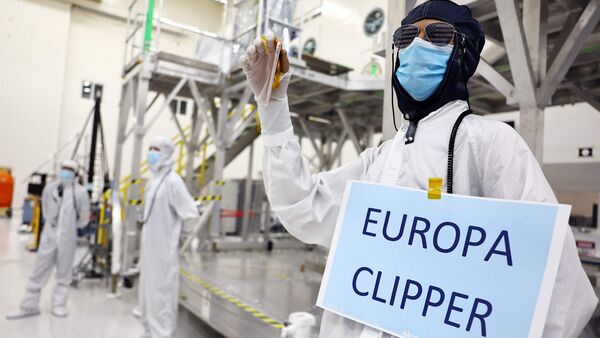American space researchers announced on Thursday that the upcoming interplanetary mission, aimed at exploring one of Jupiter’s icy moons, represents a significant advancement in humanity’s pursuit of discovering extraterrestrial life.
The Clipper spacecraft, scheduled for liftoff in October, is poised to commence its voyage towards Europa, a prominent moon of Jupiter, as reported by AFP. Europa stands out due to its potential to host environments conducive to life within our solar system.
Bob Pappalardo, the project scientist for the mission, expressed NASA’s profound interest in answering the fundamental question of the existence of life beyond Earth, stating, “Are we alone in the cosmos?”
In Pasadena, California, workers at the Jet Propulsion Laboratory (JPL) were captured near a mannequin inside a Spacecraft Assembly Facility clean room where the NASA Europa Clipper spacecraft is being prepared for its mission to investigate Europa. This moon of Jupiter is believed to possess a subsurface global ocean beneath its icy exterior, raising the possibility of habitability.
The significance of the mission lies in the potential discovery of conditions suitable for life on Europa. Pappalardo emphasized the impact of finding life on Europa, stating that such a discovery would imply that within our solar system, Earth and Europa could serve as two examples of life, shedding light on the prevalence of life in the universe.
The $5 billion spacecraft is currently housed in a specialized clean room at NASA’s Jet Propulsion Laboratory in California, ensuring a contamination-free environment. The stringent measures in place aim to prevent the inadvertent transfer of Earthly microbes to Europa, safeguarding the integrity of the mission.
Upon its transfer to the Kennedy Space Center in Florida, the Clipper spacecraft will be launched into space aboard a Space X Falcon Heavy rocket, initiating a journey spanning over five years. This trajectory includes a gravity assist maneuver near Mars to enhance the spacecraft’s velocity.
By 2031, the spacecraft is expected to enter orbit around Jupiter and Europa, where it will conduct an extensive exploration of the moon’s icy surface. Equipped with advanced instruments such as cameras, spectrometers, a magnetometer, and radar, the spacecraft aims to analyze Europa’s ice thickness and identify potential liquid water reservoirs beneath the surface.
The mission, in collaboration with AFP, underscores the meticulous preparations and scientific aspirations driving the exploration of Europa in the quest for extraterrestrial life.
